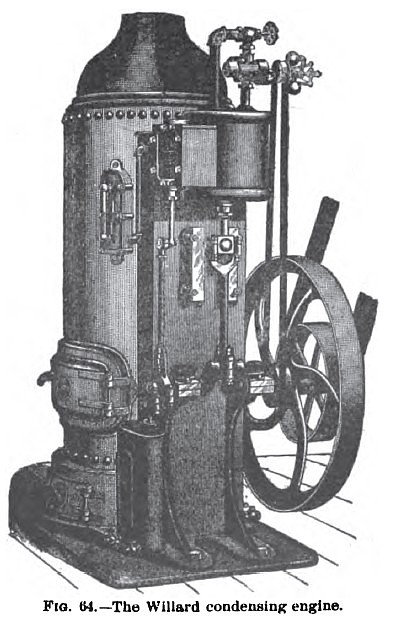|
Title: |
1895 Article-Charles P. Willard & Co., Condensing Steam Engine |
|
Source: |
Modern Mechanism 1895 pg 318-319 |
|
Insert Date: |
6/11/2011 9:15:49 PM |
The Willard Condensing Engine, made by C. P. Willard & Co., Chicago, is shown in Fig. 64. It differs from an ordinary steam-engine in the fact that while steam is made in the generator, which is a part of the machine, the only function of the steam is to create, by condensation, a vacuum, which is the motive-power. The engine is double-acting, a vacuum being created alternately at each end of the cylinder. There is no greater than atmospheric pressure in the generator, and there consequently is no danger of explosion. The condensation of the low-pressure steam, by which a vacuum is created, is effected by means of a surface-condenser, which is kept cool by water. Where the engine is to be used in a city or town having public water service, the condenser is placed in the upright iron pocket shown at the back of the engine, and a small stream of water—for the 2-horse-power, ½ in. pipe; for the 4 horse-power, ¾ in. pipe—furnishes an abundant water-supply to Keep the condenser cool. The water is admitted at the bottom, and rises to the top, and passes off through an overflow-pipe. Where there is no public water service, the engine itself operates a small pump, which causes a circulation of water.
The cylinder does not require oiling or lubrication, as the low steam used, being very moist, is a sufficient lubricant. The engine requires no attention beyond simply keeping up the fire, and giving the wheel two or three turns when ready to begin operations. There arc no exhaust, no steam-gauge, no gauge cocks, no boiler feed-pump or injector, nor any of these adjuncts of an ordinary steam-boiler. It is practically noiseless, and there is no escape of burned oil or noxious odors. Where power is needed in offices and buildings heated by n, for running ventilating-fans, printing presses, or other machinery, the engine may connected by a pipe with the steam-coil in the room, and run in this way without any generator with the machine; consequently there will be no ashes or dust, and the engine may be started or stopped by opening or closing the valve connecting with the steam coil. |
|
 1895 Charles P. Willard & Co., Condensing Steam Engine
1895 Charles P. Willard & Co., Condensing Steam Engine
|
|